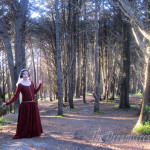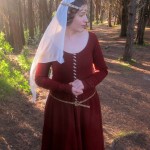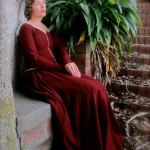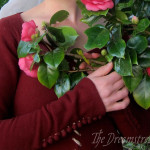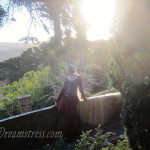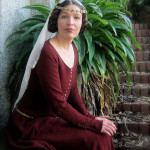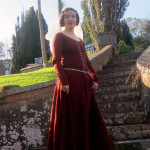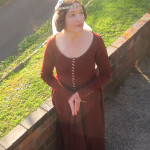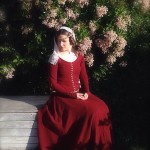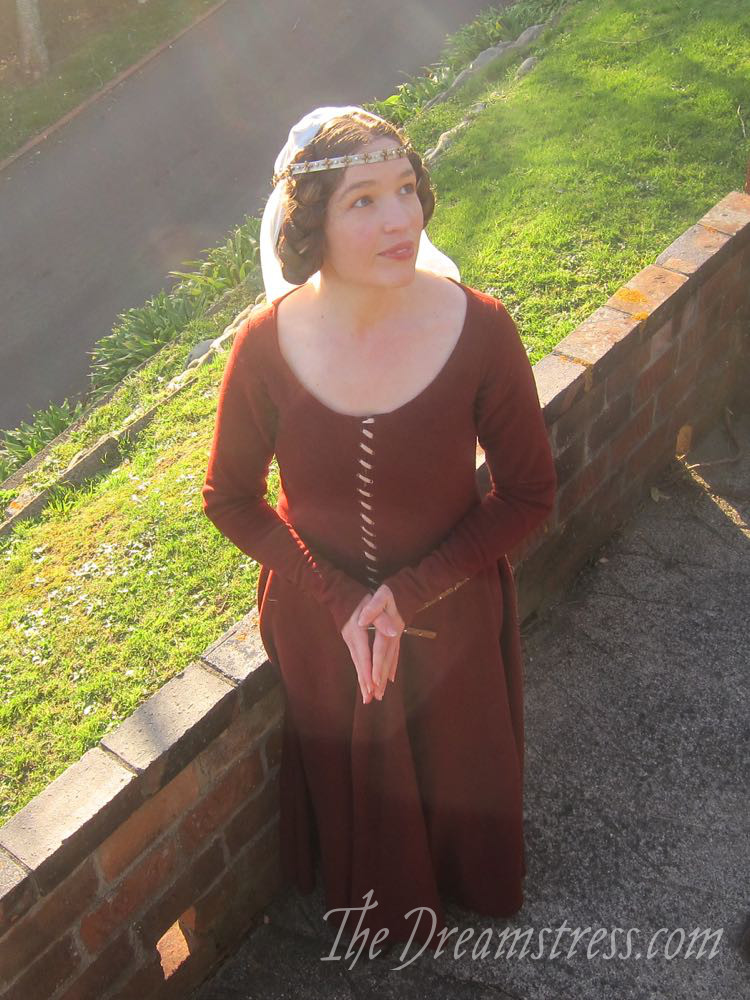
The Idea and Inspiration:
One of my aunts is a keen genealogist, and thanks to her dedicated work in researching our family history and making it available online, I’ve recently discovered that I can trace my lineage in a direct line back through Charlemagne. Most of Europe is descended from Charlemagne in some way or another, so being is great-somethingth-40+ generation granddaughter isn’t itself isn’t that exciting, but I still find it fascinating that I can look at a list and see the name of every ancestor back for over 1,000 years.
Well, every male ancestor that is. The historical records are quite precise about documenting each Sir John or Robert de Peyton who has contributed to my genetic makeup, but the names of their wives are often unknown, or misattributed. There is one particular wife of a Sir John who married him in the 1360s, but whose records are mixed up that I wondered about. Who was this minor English noblewoman, and what was her life like?
Thinking about this coincided with a growing interest in 14th century fashion, and I decided to make a dress for my unknown ancestress – something appropriate to a young minor noblewoman – upper class, but not particularly rich, or important in a wider sense. But, oh, how important to me!
This dress represents my first venture into medieval fashions, so I’m trying to balance historical accuracy, time constraints, and the knowledge that it’s almost impossible to get everything perfectly right first time. So this is a learning piece: a chance to try the fit, techniques, and the various theories that surround medieval clothing, while knowing that there will be some things I’ll want to improve next time. Because it is essentially a working toile, I’m saving time (and my chillblained fingers) by machine stitching all the long seams. Everything else will be worked by hand.
Inspiration Gallery
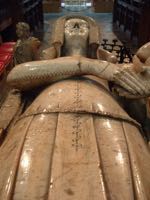 |
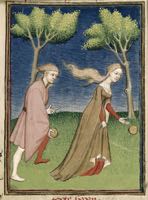 |
 |
| Katherine, Countess of Warwick, d. 1369 | Queen’s Book 128. Hippomenes & Atalante | Judgement of the King of Navarre. Maître Policratique. 1380-1395 |
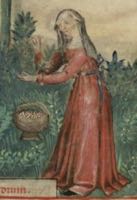 |
||
| The Tacuinum Sanitas of Vienna, Late 14th c. |
Fabric and Materials:
- A felted 70/30 wool/viscose blend in dark red-brown. In period this colour could have been achieved with a madder dye, or possibly a madder mixed with, or overdyed with, walnut. The fabric and colour match the approximate status and resources of the wife of a minor English noble of the period. The viscose content is less than ideal, but sourcing the fabric has proved very tricky, so I’ve settled for the blend.
- Linen facings
- Linen & silk thread to sew
The Undergarments:
- I’m using my nettle shift until I make a more accurate medieval shift
The Dress Diary:
- 14th century smock/shift construction: thoughts and experimentation
- Inspiration & draping the pattern
- Making Medieval buttons
- Thoughts on fit and achieving an accurate silhouette
- The final fit, and finished lacings
- Drafting & fitting medieval sleeves
- Wearing the gown at a historical dinner
- A medieval moment photoshoot
- How I made my medieval costume belt
- Wearing the gown to a ‘Medieval’ Fair
- Medieval Madness at the HSER 2019
- A St Birgitta’s Cap to wear with the dress
- A Medieval Midwinter Dinner
Research and helpful links:
Overall:
- Crowfoot, E., Pritchard, F. & Stainland, K. Textiles and Clothing c.1150-c.1450. Great Britain: Boydell Press, 2001
- Thursfield, S. 2001. The Medieval’s Tailor’s Assistant — Making Common Garments 1200-1500. Bedford: Ruth Bean Publishers, 2001 (Quite basic, and more costume than historic focused, but still helpful)
- Costly Thy Habit
- La Cotte Simple
- Som När Det Begav Sig (no, I can’t read Swedish, but google translate is a wonderful thing)
- Some Clothing of the Middle Ages
- The Battle of Whitsby, 1361-2013
- The Medieval Tailor
Draping & drafting the pattern, and achieving an accurate silhouette:
- In My Lady’s Chamber’s posts on The 14th century bust shape at (READ ALL OF THESE BEFORE you drape a pattern or pick a period)
- Tutorials on draping and making a 14th c gown at La Cotte Simple (focused on a later bust-supportive silhouette)
- Tutorials on draping a pattern and sewing a dress at Costly Thy Habit (focused on a later bust-supportive silhouette)
- A kirtle cutting layout at The Medieval Tailor
- A look at necklines at La Cotte Simple
Buttons & buttonholes:
- A buttonmaking tutorial on Som När Det Begav Sig (in Swedish, but pretty self explanatory, and with an excellent set of links)
- A buttonmaking tutorial at The Medieval Tailor
- A buttonhole tutorial at La Cotte Simple (note that Sarah of Som När Det Begav Sig & A Most Peculiar Mademoiselle uses linen thread rather than silk as recommended here, as it is more appropriate for lower class reenacting)
Sleeves:
- A sleeve drafting tutorial at the Completely Dressed Anachronist.
- Sleeve drafting and helpful seam diagrams at By My Measure
Stitches, lacing & garment details:
- Crowfoot, E., Pritchard, F. & Stainland, K. Textiles and Clothing c.1150-c.1450. Great Britain: Boydell Press, 2001
- 14th century costume details at A Most Peculiar Mademoiselle – she does great close-up pictures, and I know her stuff is really accurate.
- Lacing details at The Medieval Tailor
- The basics of spiral lacing at Festive Attyre (focused on a later period, but a good primer if you are not familiar with spiral lacing)
- More basics of spiral lacing at La Cotte Simple
- Sleeves & button plackets at The Medieval Tailor
- Hems & necklines at The Medieval Tailor (I’m slightly suspicious of the fit of her garment compared to the dating she gives, as it doesn’t match the visual record for 1340-50)
- Medieval colours & dyes at Rosalie’s Medieval Woman.

